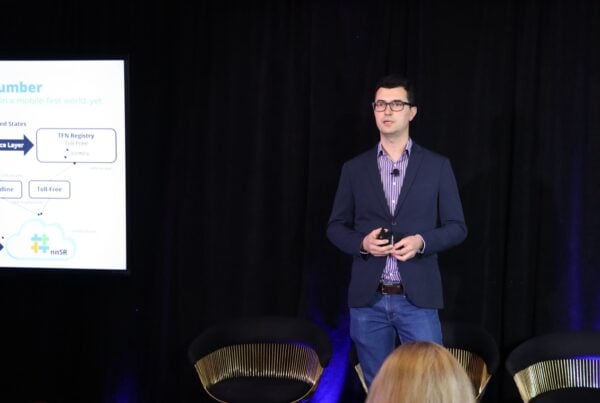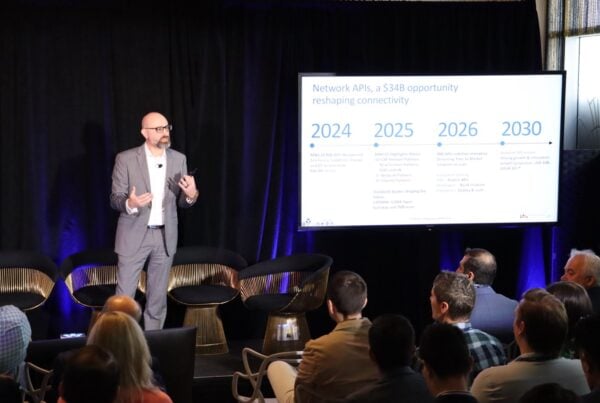We are all familiar with the terms ‘mobile’ and ‘cloud’. The former means portable, wire free connectivity and the latter means network based storage. Whilst these are obvious misconceptions its how mobile and cloud work together that provides the basis of the next wave of growth for all kinds of services. Here, Marc Kleinmaier, Head of Developer Experience in North America for Microsoft Mobile, explores the relationship between cloud-first, mobile first world.
[youtube=https://www.youtube.com/watch?v=oxYtwTXXe-o&w=500&align=right&rel=0]Marc Kleinmaier speaks with MEFTV at MEF Global Forum in San Francisco, Nov 2014
Let’s address the elephant in the room; how can two things both be first? Well, because they have to be. Mobile and the cloud are critically important on their own yet when combined, they form an inextricably symbiotic relationship that creates a sum greater than their parts. So, they’re both first… deal with it. 🙂
In order to explore what it means to live in a mobile first, cloud first world, let’s first define what’s meant when we talk about “mobile” and “cloud”. From my perspective, mobile isn’t confined to a phone or any other device that might be in your pocket. It refers to an ever expanding web of screens and sensors that are always connected… to you, your car, your home, the internet and/or themselves. Any device that isn’t (constantly) tied to the AC power in your wall and that sends/receives data, is a mobile device in my world. As for cloud… well, that’s where all this data is stored and processed. Some people hear the word, “cloud” and assume it’s just a fancy term for the internet itself or for network-based storage, but it’s so much more than that.
Today, the cloud offers a virtually unlimited amount of resources in the form of compute cycles, storage, data processing and more. Companies like Microsoft, Amazon and Google rent these resources to anyone, allowing businesses and developers to get off the ground quickly, leveraging the opportunity for instant scalability that they’d otherwise not be able to afford in terms of time, money or human resources.
So, how does this apply to our daily lives? It means we have access to more information than ever before, to help us get more done than we ever could before. In fact, the human race has generated more data in just the past two years than in all of previous history combined. We can use this information or, “big data”, to augment and improve our lives in ways we’d never dreamed of before. Something as simple as playing a video game, like Titanfall on the Xbox One leverages the power of the cloud to improve graphics performance by using pooled resources from across the globe, in real-time.
 According to Cisco, our smartphones, tablets and other digital devices generated 30 exabytes of data in 2014. This Internet of Things (IoT) is projected to churn out 292 exabytes before the end of the decade. To provide a sense of scale, that represents 292 times all the IP traffic (fixed and mobile) that was generated in the year 2000.
According to Cisco, our smartphones, tablets and other digital devices generated 30 exabytes of data in 2014. This Internet of Things (IoT) is projected to churn out 292 exabytes before the end of the decade. To provide a sense of scale, that represents 292 times all the IP traffic (fixed and mobile) that was generated in the year 2000.
Just think of what we’ll be able to do with all this data! And, how much more will be created exponentially over the next few years. A proliferation of connected sensors will provide more and more information that our devices will use to make informed decisions about what we want to accomplish and in some cases, take action upon the world around us. Just left your home? The thermostat will adjust to conserve energy, your lights will shut off, your doors will lock, and the crock-pot will start dinner. One day, the mobile devices in our pockets equipped with myriad sensors might even be used as probes to determine the radius of an earthquake or to track the spread of an airborne pathogen. The possibilities become limitless, as we erode the constraints of bandwidth, processing power and data availability.
[youtube=https://www.youtube.com/watch?v=aThCr0PsyuA&w=300&align=right&rel=0]The promise of devices like Hololens mean that we’ll soon be able to get meaningful tasks accomplished with the help of mobile computing power that’s always creating and consuming data in the cloud. The lines between real and virtual objects will be blurred by holograms and we’ll use multi-modal interfaces (voice, vision, gestures, touch) that will enable us to do things better, faster and more intuitively than ever before.
A favorite author of mine, Sir Arthur C. Clarke, famously wrote, “Any sufficiently advanced technology is indistinguishable from magic.” This becomes more evident each year and it’s this premise that makes our industry so exciting! Soon, the products and systems with which we interact on a daily basis will begin to exhibit a level of ambient intelligence powered by the cloud, enabling ubiquitous computing from any device, anytime, anywhere… like magic.
Head of MMO Developer Experience, NA
Microsoft


Developers will build apps that tap into this ambient intelligence, carrying a consistent experience for their users across every screen. It’s when this technology reaches the hands of software engineers around the world that magical things happen. New use cases that companies hadn’t envisioned will begin to bloom throughout the ecosystem, creating a snowball effect of innovation. Who knows what concepts and scenarios will spring from the minds of developers? Let’s find out.
I hope you’re as excited as I am to live during this time of exponential technology growth, which in turn, pushes humanity forward, generating a chain reaction of explosive momentum in knowledge, information and new ways to do and achieve more. This is what it means to live in a mobile first, cloud first world… and I can’t wait.






Amazing, true, insightful and I couldn’t agree more